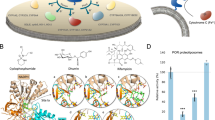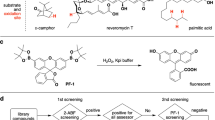Abstract
The cytochrome P450 (CYP) gene family catalyzes drug metabolism and bioactivation and is therefore relevant to drug development. We determined potency values for 17,143 compounds against five recombinant CYP isozymes (1A2, 2C9, 2C19, 2D6 and 3A4) using an in vitro bioluminescent assay. The compounds included libraries of US Food and Drug Administration (FDA)-approved drugs and screening libraries. We observed cross-library isozyme inhibition (30–78%) with important differences between libraries. Whereas only 7% of the typical screening library was inactive against all five isozymes, 33% of FDA-approved drugs were inactive, reflecting the optimized pharmacological properties of the latter. Our results suggest that low CYP 2C isozyme activity is a common property of drugs, whereas other isozymes, such as CYP 2D6, show little discrimination between drugs and unoptimized compounds found in screening libraries. We also identified chemical substructures that differentiated between the five isozymes. The pharmacological compendium described here should further the understanding of CYP isozymes.
This is a preview of subscription content, access via your institution
Access options
Subscribe to this journal
Receive 12 print issues and online access
$209.00 per year
only $17.42 per issue
Buy this article
- Purchase on Springer Link
- Instant access to full article PDF
Prices may be subject to local taxes which are calculated during checkout





Similar content being viewed by others
Accession codes
References
Evans, W.E. & Relling, M.V. Pharmacogenomics: translating functional genomics into rational therapeutics. Science 286, 487–491 (1999).
Ortiz de Montellano, P.R. (ed.) Cytochrome P450: structure, mechanism, and biochemistry. (Kluwer Acedemic/Plenum Publishers, New York, 2005).
Williams, J.A. et al. Drug-drug interactions for UDP-glucuronosyltransferase substrates: a pharmacokinetic explanation for typically observed low exposure (AUCi/AUC) ratios. Drug Metab. Disp. 32, 1201–1208 (2004).
Di, L. & Kerns, E.H. Application of pharmaceutical profiling assays for optimization of drug-like properties. Curr. Opin. Drug Discov. Devel. 8, 495–504 (2005).
Hollenberg, P.F. Characteristics and common properties of inhibitors, inducers, and activators of CYP enzymes. Drug Metab. Rev. 34, 17–35 (2002).
Lewis, D.F., Eddershaw, P.J., Dickins, M., Tarbit, M.H. & Goldfarb, P.S. Structural determinants of cytochrome P450 substrate specificity, binding affinity and catalytic rate. Chem. Biol. Interact. 115, 175–199 (1998).
Porter, T.D. & Coon, M.J. Cytochrome P-450. Multiplicity of isoforms, substrates, and catalytic and regulatory mechanisms. J. Biol. Chem. 266, 13469–13472 (1991).
Sigel, A. et al. The Ubiquitous Roles of Cytochrome P450 Proteins: Metal Ions in Life Sciences vol. 3. (John Wiley & Sons, Ltd., 2007).
Rendic, S. Summary of information on human CYP enzymes: human P450 metabolism data. Drug Metab. Rev. 34, 83–448 (2002).
Inglese, J. et al. Quantitative high-throughput screening: A titration-based approach that efficiently identifies biological activities in large chemical libraries. Proc. Natl. Acad. Sci. USA 103, 11473–11478 (2006).
Zheng, W. et al. Three classes of glucocerebrosidase inhibitors identified by quantitative high-throughput screening are chaperone leads for Gaucher disease. Proc. Natl. Acad. Sci. USA 104, 13192–13197 (2007).
Auld, D.S. et al. A basis for reduced chemical library inhibition of firefly luciferase obtained from directed evolution. J. Med. Chem. 52, 1450–1458 (2009).
Davis, R.E. et al. A cell-based assay for IκBα stabilization using a two-color dual luciferase-based sensor. Assay Drug Dev. Technol. 5, 85–104 (2007).
Xia, M. et al. Compound cytotoxicity profiling using quantitative high-throughput screening. Environ. Health Perspect. 116, 284–291 (2008).
Cali, J.J. et al. Luminogenic cytochrome P450 assays. Expert Opin. Drug Metab. Toxicol. 2, 629–645 (2006).
Lipinski, C.A. Drug-like properties and the causes of poor solubility and poor permeability. J. Pharmacol. Toxicol. Methods 44, 235–249 (2000).
Chauret, N. et al. Description of a 96-well plate assay to measure cytochrome P4503A inhibition in human liver microsomes using a selective fluorescent probe. Anal. Biochem. 276, 215–226 (1999).
Kenworthy, K.E., Bloomer, J.C., Clarke, S.E. & Houston, J.B. CYP3A4 drug interactions: correlation of 10 in vitro probe substrates. Br. J. Clin. Pharmacol. 48, 716–727 (1999).
Kohonen, T. Self-organizing neural projections. Neural Netw. 19, 723–733 (2006).
Kohonen, T. & Oja, E. Computing with neural networks. Science 235, 1227a (1987).
Lewis, D.F.V. A Guide to Cytochrome P450 Structure and Function (Taylor & Francis, London, 2001).
Foti, R.S. & Wahlstrom, J.L. CYP2C19 inhibition: the impact of substrate probe selection on in vitro inhibition profiles. Drug Metab. Dispos. 36, 523–528 (2008).
Kumar, V. et al. CYP2C9 inhibition: impact of probe selection and pharmacogenetics on in vitro inhibition profiles. Drug Metab. Dispos. 34, 1966–1975 (2006).
Nath, A. & Atkins, W.M. Principal component analysis of CYP2C9 and CYP3A4 probe substrate/inhibitor panels. Drug Metab. Dispos. 36, 2151–2155 (2008).
Shimada, T. et al. Cytochrome P450-dependent drug oxidation activities in liver microsomes of various animal species including rats, guinea pigs, dogs, monkeys, and humans. Arch. Toxicol. 71, 401–408 (1997).
Shimada, T., Yamazaki, H., Mimura, M., Inui, Y. & Guengerich, F.P. Inter-individual variations in human liver cytochrome P-450 enzymes involved in the oxidation of drugs, carcinogens and toxic chemicals: studies with liver microsomes of 30 Japanese and 30 Caucasians. J. Pharmacol. Exp. Ther. 270, 414–423 (1994).
Wienkers, L.C. & Heath, T.G. Predicting in vivo drug interactions from in vitro drug discovery data. Nat. Rev. Drug Discov. 4, 825–833 (2005).
Lewis, D.F. & Ito, Y. Human cytochromes P450 in the metabolism of drugs: new molecular models of enzyme-substrate interactions. Expert Opin. Drug Metab. Toxicol. 4, 1181–1186 (2008).
de Graaf, C., Pospisil, P., Pos, W., Folkers, G. & Vermeulen, N.P. Binding mode prediction of cytochrome p450 and thymidine kinase protein-ligand complexes by consideration of water and rescoring in automated docking. J. Med. Chem. 48, 2308–2318 (2005).
de Graaf, C., Vermeulen, N.P. & Feenstra, K.A. Cytochrome p450 in silico: an integrative modeling approach. J. Med. Chem. 48, 2725–2755 (2005).
Ekins, S., de Groot, M.J. & Jones, J.P. Pharmacophore and three-dimensional quantitative structure activity relationship methods for modeling cytochrome p450 active sites. Drug Metab. Dispos. 29, 936–944 (2001).
Hansch, C., Leo, A., Mekapati, S.B. & Kurup, A. QSAR and ADME. Bioorg. Med. Chem. 12, 3391–3400 (2004).
Hansch, C., Mekapati, S.B., Kurup, A. & Verma, R.P. QSAR of cytochrome P450. Drug Metab. Rev. 36, 105–156 (2004).
Fox, T. & Kriegl, J.M. Linear quantitative structure-activity relationships for the interaction of small molecules with human cytochrome P450 isoenzymes. Annual Reports in Computational Chemistry vol. 3 (eds. Spellmeyer, D. and Wheeler, R.) 64–84, (Elsevier, New York, 2007).
Yasgar, A. et al. Compound management for quantitative high-throughput screening. J. Assoc. Lab. Autom. 13, 79–89 (2008).
Shukla, S.J. et al. Identification of pregnane X receptor ligands using time-resolved fluorescence resonance energy transfer and quantitative high-throughput screening. Assay Drug Dev. Technol. 7, 143–169 (2009).
Feng, B.Y. et al. A high-throughput screen for aggregation-based inhibition in a large compound library. J. Med. Chem. 50, 2385–2390 (2007).
Goode, D.R., Totten, R.K., Heeres, J.T. & Hergenrother, P.J. Identification of promiscuous small molecule activators in high-throughput enzyme activation screens. J. Med. Chem. 51, 2346–2349 (2008).
Shoichet, B.K. Interpreting steep dose-response curves in early inhibitor discovery. J. Med. Chem. 49, 7274–7277 (2006).
Eagling, V.A., Tjia, J.F. & Back, D.J. Differential selectivity of cytochrome P450 inhibitors against probe substrates in human and rat liver microsomes. Br. J. Clin. Pharmacol. 45, 107–114 (1998).
von Moltke, L.L. et al. Phenacetin O-deethylation by human liver microsomes in vitro: inhibition by chemical probes, SSRI antidepressants, nefazodone and venlafaxine. Psychopharmacology (Berl.) 128, 398–407 (1996).
Zhang, J.H., Chung, T.D. & Oldenburg, K.R. A simple statistical parameter for use in evaluation and validation of high throughput screening assays. J. Biomol. Screen. 4, 67–73 (1999).
Huang, R. et al. Characterization of diversity in toxicity mechanism using in vitro cytotoxicity assays in quantitative high throughput screening. Chem. Res. Toxicol. 21, 659–667 (2008).
Eastwood, B.J. et al. The minimum significant ratio: a statistical parameter to characterize the reproducibility of potency estimates from concentration-response assays and estimation by replicate-experiment studies. J. Biomol. Screen. 11, 253–261 (2006).
Weininger, D. Smiles, a chemical language and information system. 1. Introduction to methodology and encoding rules. J. Chem. Inf. Comput. Sci. 28, 31–36 (1988).
Kohonen, T. The self-organizing map. Neurocomputing 21, 1–6 (1998).
Arimoto, R., Prasad, M.A. & Gifford, E.M. Development of CYP3A4 inhibition models: comparisons of machine-learning techniques and molecular descriptors. J. Biomol. Screen. 10, 197–205 (2005).
Cohen, L.H., Remley, M.J., Raunig, D. & Vaz, A.D. In vitro drug interactions of cytochrome p450: an evaluation of fluorogenic to conventional substrates. Drug Metab. Dispos. 31, 1005–1015 (2003).
Schulz, M. & Schmoldt, A. Therapeutic and toxic blood concentrations of more than 800 drugs and other xenobiotics. Pharmazie 58, 447–474 (2003).
Zlokarnik, G., Grootenhuis, P.D. & Watson, J.B. High throughput P450 inhibition screens in early drug discovery. Drug Discov. Today 10, 1443–1450 (2005).
Acknowledgements
This research was supported by the Molecular Libraries Initiative of the National Institutes of Health Roadmap for Medical Research and the Intramural Research Program of the National Human Genome Research Institute. Work in Trinity College Dublin was supported by Enterprise Ireland, the Chemical Computing Group, OpenEye Scientific and Accelrys. We thank S. Jefferies and G. Carta for helpful discussions, S. Michael and C. Klumpp for help with robotic automation of the assays and P. Shinn for preparation of compound dilutions and library plates.
Author information
Authors and Affiliations
Contributions
H.V. collected experimental data; H.V., N.S., R.H., T.J., D.F., N.A., M.S., D.G.L. and D.S.A. performed analysis; H.V., N.S., T.J., D.F., R.H., D.G.L., J.I., C.P.A. and D.S.A wrote the paper.
Corresponding author
Supplementary information
Supplementary Text and Figures
Supplementary Figs. 1–8 and Supplementary Table 2 (PDF 524 kb)
Supplementary Table 1
CYP activity of substructures (XLS 870 kb)
Rights and permissions
About this article
Cite this article
Veith, H., Southall, N., Huang, R. et al. Comprehensive characterization of cytochrome P450 isozyme selectivity across chemical libraries. Nat Biotechnol 27, 1050–1055 (2009). https://doi.org/10.1038/nbt.1581
Received:
Accepted:
Published:
Issue Date:
DOI: https://doi.org/10.1038/nbt.1581
This article is cited by
-
Application of variational graph encoders as an effective generalist algorithm in computer-aided drug design
Nature Machine Intelligence (2023)
-
A molecular analysis of substituted phenylethylamines as potential microtubule targeting agents through in silico methods and in vitro microtubule-polymerization activity
Scientific Reports (2023)
-
A knowledge-guided pre-training framework for improving molecular representation learning
Nature Communications (2023)
-
In-vitro antiviral activity and in-silico targeted study of quinoline-3-carboxylate derivatives against SARS-Cov-2 isolate
Molecular Diversity (2023)
-
Exploration of chemical space with partial labeled noisy student self-training and self-supervised graph embedding
BMC Bioinformatics (2022)



